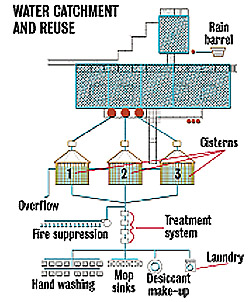The headquarters building for the chesapeake bay Foundation, in Annapolis, Md., is an extension of the owner's mission to protect and restore the health of its surroundings. "Our expertise is the Chesapeake Bay and how to save it," says Chuck Foster, the foundation's chief of staff. "The building is part of that," he adds.
The $7.2-million, 32,000-sq-ft facility, on a 31-acre water-front site, is composed of two double-story, loft-like sheds�an office building and a conference center�that are raised above the ground on pier foundations. Both volumes have glazed south-facing fa�ades with operable windows to take advantage of prevalent bay breezes and to maximize passive solar benefit. A fixed-louver sun shade lets in low winter sun but shields the building from heat gain in summer.
Some of these measures were almost too effective. When the foundation moved in late 2000, close to winter solstice, "everyone was sitting at their desks in sunglasses," says Greg Mella, project architect in the Washington, D.C., office of the SmithGroup. "The trick is to let in enough light to heat the building but without glare," he explains. To solve the problem, the designers later added venetian blinds.
The building pairs passive solar strategies with natural ventilation. Indoor and outdoor sensors monitor temperature and humidity. When conditions are optimal, cooling equipment shuts down automatically and a green light notifies occupants to open windows.
 |
| (Diagram courtesy of Smith Group) |
The building also has a geothermal exchange loop to regulate indoor conditions. The system uses the earth's stable temperature to cool the building in summer and heat it in winter. The system circulates water through 48 vertical wells, each 300-ft deep.
Stormwater management and water conservation features, such as permeable paving, restored wetlands and a rainwater collection system, respond directly to the client's goal to protect the bay. "When it rains, we try to send as few pollutants to the bay as possible," says Foster.
In addition to dovetailing with the foundation's mission, the rainwater catchment system made economic sense. It consists of three 6,500-gal cisterns on the north side of the building that supply water for the fire suppression system and other non-potable uses. An existing well did not have the required capacity and extending the municipal water supply to the site would have been a "huge first cost," says Cindy Cogil, project engineer for the SmithGroup.
 |
| LIGHT Winter sun has long reach. (Photo courtesy of the Smith Group � 2001/ Prakesh Patel) |
But not all the design decisions were made on the basis of life-cycle costs. Though payback was estimated to take between 25 and 30 years, a photovoltaic array on the building's south facade was kept in the project. Despite the poor return on investment, the client felt it was important to retain the panels as a teaching tool, says Cogil. The array produces only 3.3 Kw, less than 2% of the building's power. "The technology is just not there yet," she says.
The National Renewable Energy Laboratory, Golden, Colo., is monitoring the Chesapeake Bay Foundation, along with eight other buildings, as part of its high-performance buildings initiative. The building is designed to consume 50% less energy than a typical office building of the same size.
The two-year study will not be completed until the summer of 2003. However, preliminary data indicates that the building is performing well, except that receptacle loads are higher than expected. Michael Deru, NREL senior engineer, says that this is a typical problem in many buildings that he attributes to the difficulty of predicting occupant behavior. All in all, the Chesapeake Bay Foundation is "an excellent building," he says."We want to study what makes it good, improve its performance and pass this knowledge on to the building industry."
